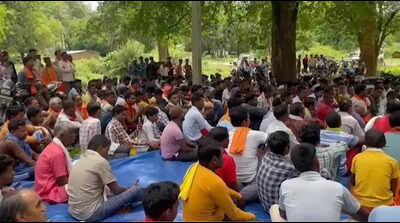ARTICLE AD BOX

RAIPUR:
Chhattisgarh's Bastar is witnessing rising tensions as the proposed Bodhghat multi-purpose project faces fierce resistance from local tribal and rural communities. Concerns over massive displacement, environmental destruction, and cultural erosion have sparked widespread protests.
Over 50,000 people are feared to be displaced by the project, which is expected to directly affect 57 villages. Locals, primarily tribal communities, have taken a firm stance, saying they will not give up even an inch of their ancestral land. People from about 30 villages, once silent, have now united in vocal opposition. “Where will we go? Over villagers of 18 panchayats will be affected. Our culture and religious life will go for a toss and none of us want to get displaced.
There can be no development by destroying villages. They have enough power capacity, what’s the need? It’s not called development when the local people suffer,” said Komal Netam, one of the local protestors. The matter suddenly got flared up after Chhattisgarh govt announced the revival of the Bodhghat multipurpose project pending since years, with investment worth Rs 49,000 crore to irrigate 3.5 lakh hectares in Bastar.
The project is to be planned on the Indravati River in Dantewada district, aims to provide permanent irrigation and generate electricity for the rural areas of Dantewada, Bijapur, and Sukma districts. The project is aiming generate 5,000 megawatts of electricity and promises to support irrigation, fish farming, and drinking water supply. But, over 13,783 hectares of forest land and private farmland are projected to be submerged, including rich biodiversity such as sal, teak, and mahua trees. In Hitalkudum and surrounding areas of Dantewada and Bijapur districts, thousands of villagers have gathered in large numbers to protest. They argue that the destruction of their land and way of life is unacceptable. “We will give our lives, but not our land,” said Netam. This is not the first time that tribal communities are fighting to protect their sovereignty and culture. “We have gathered to make our voices heard, urging the govt to reconsider the project.” Meanwhile, Congress state president Deepak Baij – who comes from Bastar- has showed solidarity with the affected communities and promising support under any circumstances. “Congress is with tribal people, if they want the project, fine, but when they don’t want, then there’s no way. What’s the plan with govt for their displacement, it should be made clear before taking any step towards the Bodhghat project,” Baij said. As political attention intensifies, the state govt’s position remains ambiguous. However, both the state and central governments continue to promote the Bodhghat project as a multi-purpose solution for the region. BJP state president Kiran Singh Deo- who is also from Bastar- suggested that the govt is serious about moving forward with what is being called a long-awaited development initiative for Bastar. Though the project makes big promises, yet, with growing public resistance and unanswered questions around displacement and ecological damage, it is unclear how far the project will progress under the mounting pressure of protest.
For now, the future of the Bodhghat Hydropower Project hangs in the balance. Bastar, a region long affected by Maoist insurgency, has historically lagged behind in the development of basic infrastructure—particularly irrigation facilities. Addressing this gap, Chhattisgarh Chief Minister Vishnu Deo Sai stated that the state government is pursuing large-scale infrastructure initiatives, including the Bodhghat Multipurpose Dam Project and the Indravati-Mahanadi Link Project, to support the region’s comprehensive development.
These projects will take shape once govt achieves the March 31, 2026 target of Maoist elimination. The Bodhghat Dam, proposed on the Indravati River, a major tributary of the Godavari, has been in limbo for over 45 years due to inter-state water disputes and security challenges. According to the govt offciials, the project will play a key role in unlocking Bastar’s economic potential and improving the quality of life in the region.



.png)
.png)
.png)
















 5 hours ago
5
5 hours ago
5









 English (US) ·
English (US) ·